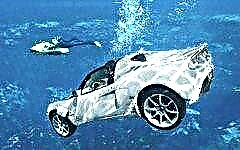

The content of the article:
- Sinking car
- What is the REGS system
- Principle of operation
The statistics of sinking cars over the past year are not the best. In each country, these indicators are different, the figure for the territory of Russia is at least 10 cars per month, especially in the part of the country where there are large water resources.
The Dutch company, a leading manufacturer in the development of active and passive safety systems, has developed and is actively implementing the REGS (Rescue and Escape Guidance System) system. In another way, it is a system for rescuing passengers from a sinking car. Since the advent of vehicles, vast numbers have been buried under water. There are many reasons for this, but most often through the fault of the driver himself.
How to escape from a sinking car

During the existence of cars, many safety systems have been invented to rescue passengers from a sinking car. Some of them were effective, some, on the contrary, only accelerated the process of diving the car. Most of all, the statistics of drowned cars concerns the area where the road route passes near waterways and the more water, the more likely this situation is.
The main problem for car passengers, at the moment when it sinks, is to open the door. Due to the external water pressure, this is not so easy to do, especially if the depth of the reservoir is large enough. Another situation is attempts to break one of the car windows, as a rule, they try to break the side glass. If in the first cars this could be done with the help of heavy or piercing objects, then in modern cars glass is often much stronger than metal surfaces.

Some drivers have adapted to carry a small hammer or the like with them, but you can't predict the situation. Statistics show that dozens of such accidents end in the death of passengers. If it comes to self-salvation, then the first thing is not to panic, otherwise you are aggravating the situation. If the glass cannot be broken, wait until the car is filled with water at least above the middle of the glass.
Due to the equalization of pressures inside the car and outside, the door will be easier to open. If it is possible to break the glass, then it is worth doing this before the interior is completely filled with water. The blow must be accurate and in one target, if several times. It is more likely that the glass will be broken faster and as soon as the pressure levels up, you can leave the car, otherwise, under the pressure of water, you will be pushed back into the interior of the car.
REGS system design

The Dutch developers have tried to finalize the system for rescuing passengers from a sinking car as much as possible, since there should be no chance of a mistake. The main task of the REGS system is to destroy the glass of the car as soon as it enters the water at a certain level. This contributes to a smooth and quick release from the vehicle.A number of pressure sensors are installed at the heart of the REGS system (rescue passengers from a sinking vehicle). The first models of the system were equipped with one sensor for each door. Now there are two sensors, one is the main sensor, and the second is the control one. A so-called activator is connected to each sensor, which starts the operation of the entire system. As a rule, such a REGS activator is attached to the lower end of the glass, behind the door trim.
A metal striker and an igniter are sequentially attached to the activator. Thus, after the REGS system has been triggered, the glass is delaminated and divided into small pieces. Under external water pressure, the glass will crumble on its own, thereby freeing the passage to the outside.
How the REGS system works

If the car is immersed in water, the REGS system will work without errors, since it is completely autonomous and does not depend on the main power system of the car. Engineers designed it for the most extreme operating conditions. As soon as water enters the car to a certain level and pressure, the sensor immediately responds and generates a start signal to trigger the system.
In turn, the signal is transmitted to the activator of the REGS system, the latter transmits the signal to the squib. Due to the triggering of the squib, the output of the charge is transmitted to the firing pin. An important role is played by the location of the striker, it should only be at the end of the glass, otherwise the expected effect will not occur or only part of the glass will break.

Due to the end impact, hundreds of small cracks appear on the glass over the entire surface. After the REGS system (system for rescuing passengers from a sinking car) is triggered, glass can be broken with minimal effort, or you do not have to break it at all. With the progress of the REGS system refinement, it began to be equipped with waterproof LED strips along the edges, as well as special sensors that turn on the LED strip if the car gets under water.
Due to the backlighting of the windows, it is easier to orient the passenger of the car to the side windows, in case of muddy water or at night. For the first time, the REGS system of rescuing passengers from a sinking car was tested on Volvo cars, success was not long in coming. Now the issue of the full purchase of the rights to the REGS system is being decided, since the Swedish manufacturer from 2019 plans to equip all production vehicles, including trucks.











